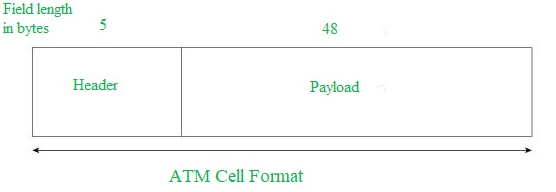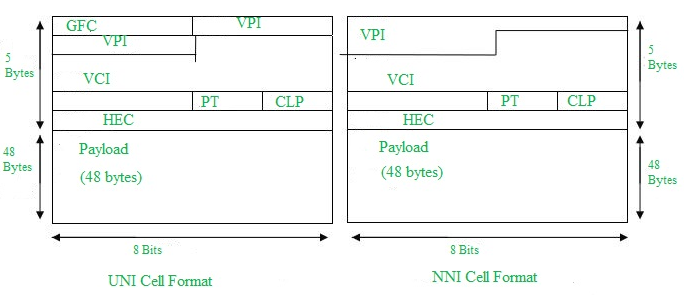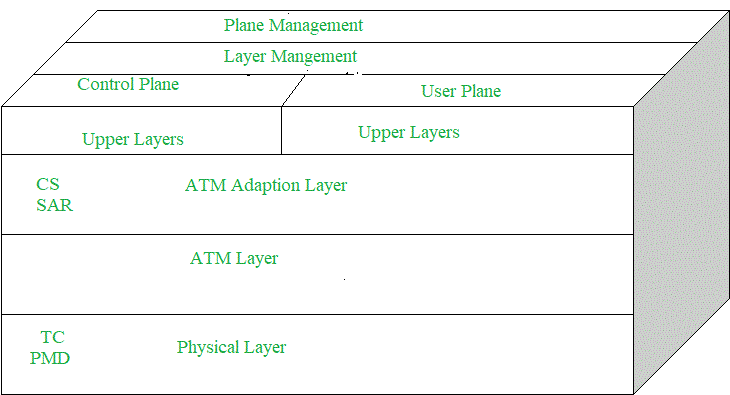What Is The Size Of An Atm Packet?ã¢â‚¬â€¹
Why ATM networks?
- Driven by the integration of services and performance requirements of both telephony and data networking: "broadband integrated service vision" (B-ISON).
- Telephone networks support a single quality of service and are expensive to boot.
- Internet supports no quality of service but is flexible and inexpensive.
- ATM networks were meant to back up a range of service qualities at a reasonable cost- intended to subsume both the telephone network and the Internet.
Asynchronous Transfer Way (ATM):
Information technology is an International Telecommunications Union- Telecommunications Standards Section (ITU-T) efficient for phone call relay and it transmits all information including multiple service types such as information, video, or vox which is conveyed in minor fixed-size packets called cells. Cells are transmitted asynchronously and the network is connection-oriented.
ATM is a engineering that has some result in the development of broadband ISDN in the 1970s and 1980s, which tin be considered an evolution of packet switching. Each cell is 53 bytes long – v bytes header and 48 bytes payload. Making an ATM phone call requires first sending a message to ready a connexion.
Subsequently, all cells follow the same path to the destination. Information technology tin can handle both abiding rate traffic and variable rate traffic. Thus it can carry multiple types of traffic with end-to-end quality of service. ATM is independent of a transmission medium, they may exist sent on a wire or fiber by themselves or they may also exist packaged inside the payload of other carrier systems. ATM networks use "Packet" or "cell" Switching with virtual circuits. Its design helps in the implementation of high-functioning multimedia networking.
ATM Cell Format –
Equally information is transmitted in ATM in the class of fixed-size units called cells. As known already each cell is 53 bytes long which consists of a 5 bytes header and 48 bytes payload.

Asynchronous Transfer Mode can be of two format types which are as follows:

- UNI Header: This is used inside private networks of ATMs for communication between ATM endpoints and ATM switches. It includes the Generic Menses Command (GFC) field.
- NNI Header: is used for advice between ATM switches, and it does not include the Generic Flow Control(GFC) instead it includes a Virtual Path Identifier (VPI) which occupies the kickoff 12 bits.
Working of ATM:
ATM standard uses two types of connections. i.e., Virtual path connections (VPCs) which consist of Virtual channel connections (VCCs) bundled together which is a basic unit of measurement conveying a single stream of cells from user to user. A virtual path can exist created end-to-end across an ATM network, as it does not rout the cells to a particular virtual circuit. In case of major failure, all cells belonging to a item virtual path are routed the same way through the ATM network, thus helping in faster recovery.
Switches continued to subscribers employ both VPIs and VCIs to switch the cells which are Virtual Path and Virtual Connectedness switches that can take different virtual channel connections between them, serving the purpose of creating a virtual trunk between the switches which can be handled as a single entity. Its basic operation is straightforward by looking up the connexion value in the local translation table determining the outgoing port of the connection and the new VPI/VCI value of connexion on that link.
ATM vs DATA Networks (Internet) –
- ATM is a "virtual excursion" based: the path is reserved before manual. While Internet Protocol (IP) is connectionless and cease-to-end resource reservations are not possible. RSVP is a new signaling protocol on the internet.
- ATM Cells: Stock-still or small size and Tradeoff is between vocalism or information. While IP packets are of variable size.
- Addressing: ATM uses 20-byte global NSAP addresses for signaling and 32-fleck locally assigned labels in cells. While IP uses 32-bit global addresses in all packets.
ATM Layers:

- ATM Adaption Layer (AAL) –
Information technology is meant for isolating higher-layer protocols from details of ATM processes and prepares for conversion of user information into cells and segments it into 48-byte cell payloads. AAL protocol excepts manual from upper-layer services and helps them in mapping applications, eastward.yard., phonation, information to ATM cells. - Physical Layer –
It manages the medium-dependent transmission and is divided into ii parts physical medium-dependent sublayer and manual convergence sublayer. The main functions are every bit follows:- It converts cells into a bitstream.
- It controls the manual and receipt of bits in the concrete medium.
- Information technology can track the ATM prison cell boundaries.
- Look for the packaging of cells into the appropriate type of frames.
- ATM Layer –
Information technology handles manual, switching, congestion control, cell header processing, sequential delivery, etc., and is responsible for simultaneously sharing the virtual circuits over the concrete link known as cell multiplexing and passing cells through an ATM network known as cell relay making use of the VPI and VCI information in the cell header.
ATM Applications:
- ATM WANs –
It can be used as a WAN to send cells over long distances, a router serving every bit an cease-point between ATM network and other networks, which has 2 stacks of the protocol. - Multimedia virtual individual networks and managed services –
Information technology helps in managing ATM, LAN, voice, and video services and is capable of full-service virtual private networking, which includes integrated access to multimedia. - Frame relay backbone –
Frame relay services are used as a networking infrastructure for a range of data services and enabling frame-relay ATM service to Internetworking services. - Residential broadband networks –
ATM is by selection provides the networking infrastructure for the establishment of residential broadband services in the search of highly scalable solutions. - Carrier infrastructure for phone and private line networks –
To make more than effective use of SONET/SDH fiber infrastructures by building the ATM infrastructure for carrying the telephonic and private-line traffic.
What Is The Size Of An Atm Packet?ã¢â‚¬â€¹,
Source: https://www.geeksforgeeks.org/asynchronous-transfer-mode-atm-in-computer-network/
Posted by: holmbergknome1944.blogspot.com


0 Response to "What Is The Size Of An Atm Packet?ã¢â‚¬â€¹"
Post a Comment